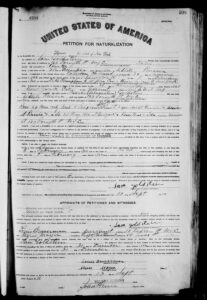From knowing next to nothing about this branch of the family, details – one rather astonishing – are now being discovered.
To remind you, Uncle Shimon is the older brother of my grandfather Sol Goldstein. Their parents were Berl Fayvel Goldsztern and Yocheved Rozenzumen. Along with Sol, he and his brother Meyer were the only members of the Goldsztern family of Terespol and Brest to immigrate to the US.
In my last post about Uncle Shimon Goldstein, I mentioned that my next step was to find his Naturalization documents; some of the US Censuses reported 1909 as the year he was naturalized, so I now had something more definitive to go on. After slogging unsuccessfully through Ancestry.com, I tried the LDS website, FamilySearch, and immediately found Uncle Shimon’s Petition for Naturalization (you can see it at the end of this post).
These Petitions are a gold mine of information, and Uncle Shimon’s did not disappoint. Here’s what I learned:
The Petition was submitted on September 13, 1910, to the New York State Supreme Court (at that time, naturalization was handled by state and local courts).
Uncle Shimon was now known as “Sam” and lived at 127 Forsythe Street, New York. He occupation was painter (house painter), consistent with his other documents.
He gives his birthday as December 25 1880, in “Sedlitz,” Russia. When Shimon was born “Sedlitz” or, more properly, Siedlce, was the province where Terespol was situated and Poland was part of the Russian Empire. His birth registration says Terespol on December 21, 1878, but such discrepancies are very common in documents of the time. Furthermore, his birth had to be registered in Terespol where his parents lived, but it’s possible that he was actually born in the town of Siedlce.
He sailed from Rotterdam, Holland on January 20, 1900 on the SS Lake Champlain and landed in St. John, New Brunswick, Canada; from there he took a train to New York City, where he arrived on February 5, 1900.
His wife Gittel is listed in the Petition as “Gertie;” in all other documents she is “Gussie.” People changed their names repeatedly and there was no need then to do so legally.
Their children were Rose (b. 1906), Max (b. 1908) and Ida (b. 1910).
And then a previously unknown child is listed! Surprise! Hershel was born April 2, 1900 and is listed as “residing at Russia!” What?? Why is his eldest child in Russia and not in New York with his parents?
Hershel was born two and a half months after Shimon left Europe and by the time Shimon petitioned for naturalization, was ten years old. Hershel was clearly still alive because his current residence is listed.
I’m imagining that Gittel lived with her parents when the child was born, as her husband was in the US.
Gittel arrived in New York in 1905 without Hershel, when the boy would have been five years old. Why did he not accompany her? Perhaps he was sickly or disabled and therefore would not have been admitted to the US and would have been sent back to Poland. Perhaps his grandparents did not want to part with him; they knew they would never see Gittel again and certainly not her subsequent children. Perhaps Hershel was closer with his grandparents than with his mother. Perhaps Shimon told her not to bring him. Who knows??
And this is sobering: when you look at the dates you realize that Shimon never met his first child, unless Hershel arrived in the US later.
So yet again, solving one mystery – in this case finding Shimon’s Petition for Naturalization – leads to more mysteries. Genealogy is thus the hobby that never ends, which is just delightful! I’ve already searched some online resources for Hershel and Gittel in Poland – no luck yet – and will have to explore whether he ever did come to the US.

I’m staying tuned!